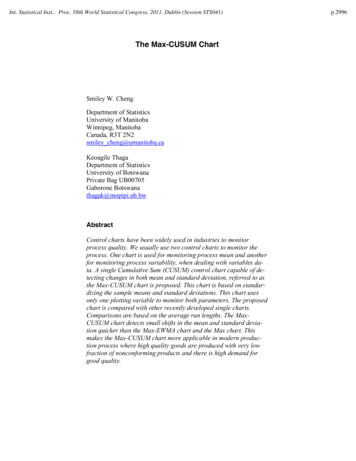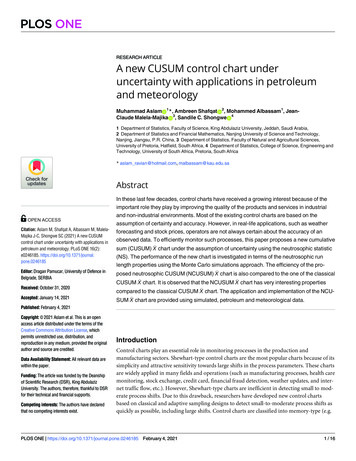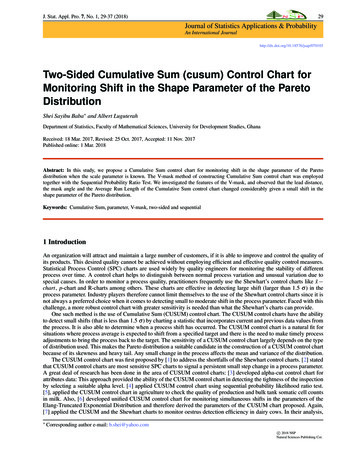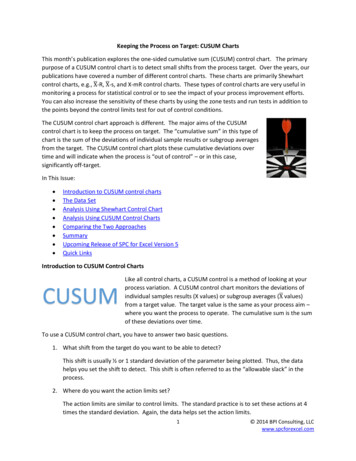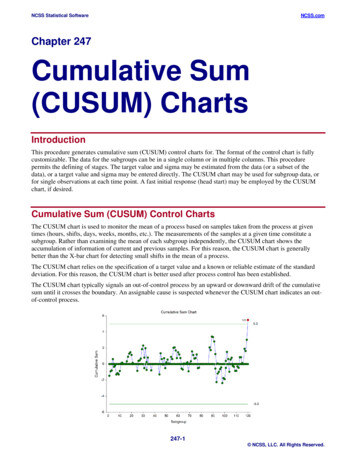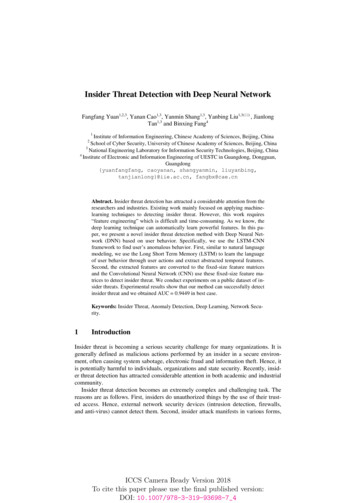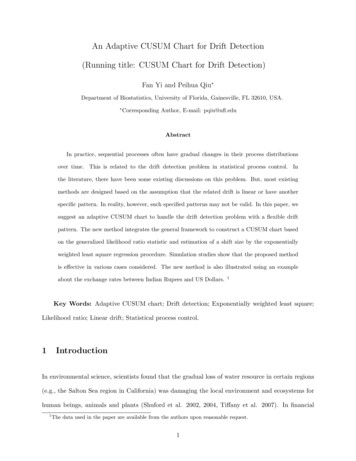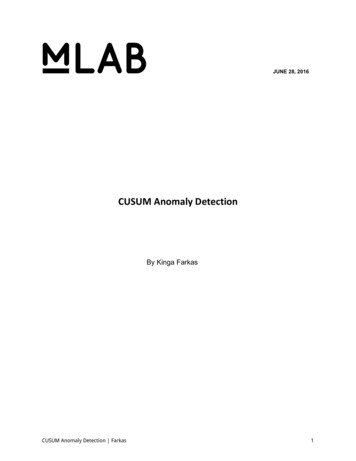
Transcription
JUNE 28, 2016 CUSUM Anomaly DetectionBy Kinga FarkasCUSUM Anomaly Detection Farkas1
AbstractIntroductionBackgroundAnomaly Detection in Network Traffic FlowsCUSUM ChartsCUSUM Anomaly Detection (CAD)Applying CUSUM Charts to Internet Performance VariablesCAD’s DesignOverviewSliding WindowsFinding the Training SetApplying the CUSUM ChartInterpreting the CUSUM Chart ResultsTuning ParametersExamples and ResultsExample 1: CAD Applied to the Time Series from the ISP Interconnection and its Impacton Consumer Internet Performance StudyExample 2: CAD Applied to Data collected from Iran before, during and after the 2013Iranian Presidential ElectionsEvaluation of CAD’s PerformanceConclusion 2016 Measurement Lab ConsortiumCUSUM Anomaly Detection Farkas2
AbstractToday, researchers can collect data on a wide range of indicators related to Internet access,speed, and latency. What can we learn from all this data? There is an increasing need foranalysis that uses automated methods to sift through the data and uncover unusual patterns,outliers, and anomalous sequences.The CUSUM anomaly detection (CAD) method is based on CUSUM statistical process controlcharts. CAD is used to detect anomalous subsequences of a time series that show a subtleshift in the mean relative to the context of the sequence itself. CAD was applied in order to lookfor anomalies in M Lab’s database of Network Diagnostic Test (NDT) results. CAD’s success isbased on the observation that the NDT time series can be viewed as being comprised of varyinglength subsequences of real valued random variates, where each of these subsequencescorrespond to a normal distribution with a specific mean and standard deviation.We describe the basic design of CAD, illustrate how it functions by applying it to time seriesfrom M Lab’s NDT database that contain known anomalies, and demonstrate its effectivenessby showing that CAD successfully and automatically detected each of the Internet performancedegradation incidents with very few false negatives or false positives.IntroductionM Lab’s mission is “ to advance network research and empower the public with usefulinformation about their broadband and mobile connections. By enhancing Internet transparency,M Lab helps sustain a healthy, innovative Internet.”1The CUSUM anomaly detection algorithm explores the need for an automatized method ofsearching M Lab’s vast database of Network Diagnostic Test (NDT) results not for single outlierpoints, but for a series of unusually high or low measurements. This project was developedduring the course of a three month long “Outreachy”2 internship at Measurement Lab in thesummer of 2015.One of the most important features of the algorithm is finding and defining the “normal” patternfor the time series, relative to which deviations could be classified as anomalies. Using a slidingwindow technique the statistically significant shifts in the mean are detected relative to the“normal pattern” (the training set). The output of the algorithm is the potential list of anomaliesalong with the corresponding plot of the time series and its anomalies.12Measurement Lab, About, http://www.measurementlab.net/about .GNOME Foundation, OUTREACHY, https://www.gnome.org/outreachy/ .CUSUM Anomaly Detection Farkas3
BackgroundAnomaly Detection in Network Traffic FlowsThere have been several attempts to characterize time series of network traffic flows to detectanomalies, which include outages, abuse, or Internet filtering. Anomaly detection is becomingan increasingly studied field, given the central role that the Internet plays in globalcommunications. These methodologies vary from a symbolic representation of time series to anautomated detection of Internet filtering3.In their paper, A symbolic representation of Time series, with implications for streamingalgorithms, J. Lin E. Keogh, S. Lonardi, B. Chiu4 make an attempt to create a representation oftime series “that allows dimensionality/numerosity reduction, and it also allows distancemeasures to be defined on the symbolic approach that lower bound corresponding distancemeasures defined on the original series”.5In Visualizing and discovering non trivial patterns in large time series databases, the sameauthors describe a time series pattern discovery and visualization system, VizTree, based onaugmenting suffix trees. VizTree visually summarizes both the global and local structures oftime series data at the same time. This provides solutions to motif discovery, anomaly detectionand query content.P. Bartford and D. Plonka6 describe their work of collecting and analyzing network flow data byusing FlowScan open source software. The goal of their work is to identify the statisticalproperties of anomalies and, if they exist, their invariant properties.The most comprehensive and elaborated work in detecting Internet filtering from geographictime series is presented by J. Wright, A. Darer and O. Farnan in their paper, Detecting Internetfiltering from geographic time series7. The goal of their work is to identify global patterns ofInternet filtering through technical network measurements and to link these events to their socialcontext. Their approach to detect anomalies is based on principal component analysis. It shouldbe pointed out, that the goal CAD is very similar to theirs, but the approach is very different andbased on statistical process control.3J. Wright, A. Darer, O. Farnan, Detecting Internet filtering from geographic time series , Oxford Internet Institute, July21, 2015. http://arxiv.org/abs/1507.05819.4J. Lin , E. Keogh, S. Lonardi, B. Chiu, A symbolic representation of Time series, with implications for streamingalgorithms , DMKD, June 13, 2003 San Diego, CA, USA.5J. Lin, E. Keogh, S. Lonardi, Visualizing and discovering non trivial patterns in large time series databases ,Information Visualization (2005), 4, 61 82.6P. Barford and D. Plonka, Characteristics of network traffic flow anomalies , C.S. Department at the University ofWisconsin, Madison (2001).7J. Wright, A. Darer, O. Farnan. Detecting Internet filtering from geographic time series.CUSUM Anomaly Detection Farkas4
CUSUM ChartsStatistical control charts are graphs that are used to show how a process changes over time.All statistical control charts have a center line for the average and an upper control and a lowercontrol line. These lines are based on historical values of the process mean and standarddeviation. An out of control process will have points on the chart that land above the uppercontrol line or below the lower control line.8The CUSUM (cumulative sum) control chart is a statistical control chart used to track thevariation of a process9. It is a method that is able to detect small shifts in the process’ mean.The CUSUM chart uses four parameters:1. the expected mean of the process, μ2. the expected standard deviation of the process, σ3. the size of the shift that is to be detected, k4. the control limit, HThe expected mean and standard deviation are defined to be the historical mean and standarddeviation of the process when the process is normal and in statistical control10. The parameterk determines the slack that is allowed in the process; its usual value is about σ . The parameterH is the threshold for the process; its value is usually set to 5σ.The CUSUM chart works by tracking the individual cumulative sums of the negative and positivedeviations from the mean, the high and low sums respectively.The high sum is given by the recursive sequence S i M ax {0, Si 1 x i μ k } , S0 0 for i 1, 2, . , Nwhereas, the low sum is defined by S i M in {0, Si 1 x i μ k } , S0 0 for i 1, 2, . , N. Note that the parameter k does indeed provide for slack in the procedure, since S i Si 1 only if xi ᵻ k and S i Si 1 only if xi ᵻ k .11 If either of the cumulative sums, S i or S i , reach thethreshold H , the process is considered out of control.As an example, consider the sequence V {vi} 240i 1 , where the vi are randomly selected from anormal distribution with a mean μ 50, and standard deviation σ 3 . This sequence thenrepresents a process that is statistically stable; its departures from the target value, the mean,μ 50, are the expected variations due to chance. Next, suppose that the middle 40 elements,14040{vi} i 101 , are replaced by {wi} i 1 , where the wi are randomly selected from a normaldistribution with mean μ 54 and standard deviation σ 3. The resulting sequence8“Control Chart,” ASQ, http://asq.org/learn about quality/data collection analysis tools/overview/control chart.html .“Keeping the Process on Target: CUSUM Charts,” BPI Consulting, LLC, 2014,http://www.spcforexcel.com/knowledge/variable control charts/keeping process target cusum charts .10D.C. Mongtomery, Introduction to Statistical Quality Control (John Wiley & Sons, 199)1, 10311“Keeping the Process on Target: CUSUM Charts,” BPI Consulting, LLC, 2014,http://www.spcforexcel.com/knowledge/variable control charts/keeping process target cusum charts .9CUSUM Anomaly Detection Farkas5
40240240V ′ {vi} 100i 1 {wi} i 1 {vi} i 141 {v′i} i 1 is no longer statistically stable because thesubsequence mean changes drastically right in the middle of the sequence.The package qcc12 in R contains an implementation of the CUSUM chart, the cusum function.Figure 1 illustrates the results as the cusum function is applied to a time series sequence V ′,created, also using R, according to the specifications described above. The CUSUMparameters were set to μ 49.83, σ 2.89 , the mean and standard deviation of V respectively,whereas the control limit was H 5σ and shift size was k σ.The time series sequence V ′ and its CUSUM chart is plotted in Figure 1. Within the plot of V ′the green and red horizontal lines indicate the mean of the original sequence V and of itsanomalous subsequence {v′i} 140i 101 respectively. The CUSUM chart of V ′ (the bottom plot ofFigure 1) detects the shift in mean of V ′, since the upper sum S i reaches and surpassesH 5σ when i 105 . Note that in the qcc package implementation of the CUSUM chart, theterm Decision interval refers to the parameter H , and the tem Shift detection to parameter k.Figure 1 : Plot of V ′ and the CUSUM Chart for V ′12L. Scrucca “qcc: an R package for quality control charting and statistical process control,” R News 4/1 (2004), pp.11 17.CUSUM Anomaly Detection Farkas6
CUSUM Anomaly Detection (CAD)The CUSUM Anomaly Detection (CAD) is a statistical method; it is an anomaly detectiontechnique for univariate time series. It uses the out of control signals of the CUSUM charts tolocate anomalous points. The detection of periodicity is not yet part of CAD nor it is a methodthat searches for measurements that do not follow the expected periodic behavior.M Lab’s data consists mainly of Network Diagnostic Test results, which means that the datacollection rate, or sampling rate, is variable. In order to create a time series of equally spacedmeasurements, the accepted practice is to find the median of the measurements per unit time.Still, short term jumps in a time series values could be due to chance alone. Therefore, CAD isoptimized to find anomalous subsequences13 of length greater than λ, where the adjustableparameter λ’s default value is 5 units of time. Specifically, CAD is not designed to findcontextual anomalies14, that is, single data points considered to be anomalous within the contextof the time series itself. CAD is designed to detect sustained changes, rather than a singleanomalous data point.Defining a Training Set and Applying CUSUM Charts to Internet PerformanceVariablesThe time series of an Internet performance variable like round trip time, download throughput orpacket retransmission rate can be viewed as output variables characterizing the process oftransmitting information through the Internet.13D. Cheboli, “A Thesis Submitted to the Faculty of the Graduate School of the University of Minnesota,” AnomalyDetection of Time Series (2010), 92985/?sequence .1 .14Ibid., 92985/?sequence 1 , 6.CUSUM Anomaly Detection Farkas7
By applying the CUSUM chart to one of these time series we implicitly create a local model forthe time series in question. This model defines the local “normal” for the time series, and it isdefined by the following:1. it is normally distributed2. it has a well defined mean and standard deviation3. it is in statistical controlAn anomaly signaled by the CUSUM chart implies a shift in the mean with respect to this localmodel of the Internet performance variable.Example: CUSUM Chart applied to an Internet performance variable time seriesConsider M Lab’s Iran daily median download throughput for the year 2013 (Figure 2)15. Inorder to be able to apply the CUSUM chart to this time series, it must have at least onesubsequence whose values have moderately normal distribution. One such subsequence, if itexists, can be used as the training set. This training set would define a local “normal” for Iran’sdaily median download throughput and it would be used to calculate the expected mean and theexpected standard deviation for the time series.Figure 2: Iran’s Daily Median Download Throughput for 2013 —An M-Lab DatasetAs it turns out, the time series in question does have such a subsequence. The measurementsduring the time period of June 9, 2013 October 6, 2013 fit the requirements. This is thesubsequence highlighted in red in Figure 3.15Iran held its presidential elections on June 14, 2013.CUSUM Anomaly Detection Farkas8
Figure 3 : Iran’s Daily Download Throughput with the Training Set in RedIn order to demonstrate that the selected training set’s distribution is close to normal, the densityplot of the training set and the normal distribution curve with the mean and standard deviation ofthe training set are shown in Figure 4. Since the experimental distribution curve (in blue) closelyapproximates the theoretical distribution curve (in red) we can claim that the selected trainingset’s distribution is close to normal.Figure 4 : Experimental and Theoretical Distributions of the Training SetCUSUM Anomaly Detection Farkas9
When the CUSUM parameters H and k are set to 5 σ and 3 σ respectively, the subsequence isin statistical control. Neither the upper nor the lower cumulative sums reach the control lines,denoted U DB (Upper Decision Boundary) and LDB (Lower Decision Boundary) as shown byFigure 5. Note that the plot of the training set was also provided in Figure 5 in order to providereference for the CUSUM chart.Figure 5: The Training Set and its CUSUM chartCUSUM Anomaly Detection Farkas10
The CUSUM chart of the entire time series is then found using the mean of the training set asthe expected mean, the standard deviation of the training set as the expected standarddeviation, and the CUSUM parameters H 5 and k 3.Figure 6 contains the graphs of the entire time series and its CUSUM chart. The red dots in theCUSUM chart of Iran Daily Median Throughput appear at the points when either the upper sumis above target or the lower sum is below target. The days over which the upper sum is abovetarget coincide with the days when time series’ values show a steep increase, whereas the daysover which the lower sum is below target coincides with the dates when the time series’ valuesdrop drastically.Figure 6 : Plot of Iran’s Daily Median Throughput and its CUSUMChartCUSUM Anomaly Detection Farkas11
CAD’s DesignOverviewThe implementation of CAD was written in R and it uses the qcc package16 to find the CUSUMchart of a time series. CAD uses the sliding window technique. For each window, CADsearches the time series along the window for a training set. If one is found, CAD applies theCUSUM chart to the entire time series along the window. After interpreting the results of theCUSUM chart, some of the points are designated as possible anomalies. This procedure isrepeated for every window down the length of the time series. The output of the process is theindexes of the anomalies within the time series and a graph of the time series with anomalies inred and a bar chart of the number of times each point was labeled an anomaly.Sliding WindowsThe length of the moving window, w , is roughly one third of the length of the entire time seriesas this length seemed to provide the best outcome . Future work could consider other values forlength or a systematic way to determine the optimal length. The window overlap is w 1 , thatis, the window is always shifted one data point to the right at a time.Finding the Training SetFor each window, the portion of the time series contained in the window is searched for atraining set.16L. Scrucca, “qcc: an R package for quality control charting and statistical process control.” R News 4/1 (2004),11 17.CUSUM Anomaly Detection Farkas12
The search starts with looking at all the subsequences with length f loor (w3 ) . If a training set isnot found the length of the subsequence is decreased by one and the process repeats untileither a subsequence is found that has the right properties or the subsequence length hasreached 24 17.The examination of each subsequence entails calculating the p value of the Shapiro Wilk test,that checks whether a random sample, y1 , y2 , , yN comes from a normal distribution. The twohypotheses of the Shapiro Wilk test are the null hypothesis (H )—the distribution is normal and0 the alternative hypothesis (H )—thedistributionisnotnormal.Whenthe p value is greater thana or equal to 0.05, H cannot be rejected. When the p value is less than 0.05, H is rejected and0 0 the distribution is considered non normal. In this last case, the subsequence is discarded sincethe points of the subsequence were proven to have a non normal distribution. For eachsubsequence for which the p value is greater than or equal to 0.05, the kurtosis and skewnessvalues are calculated, and the smallest values of the CUSUM parameters H and k for whichthe subsequence is in statistical control are identified.If the set of subsequences with a given length and with a p value greater or equal than 0.05 isnon empty, the subsequence that minimizes the quantities 1 skewness , kurtosis 3 , p value 1 , H , and k is chosen to be the training set.If the subsequence length decreases all the way to 24 and no suitable training set was found,the entire process of anomaly detection halts with the conclusion that CAD cannot be applied tothe time series in question.Applying the CUSUM ChartOnce a training set, τ , is found along with its CUSUM parameters H τ and kτ , the CUSUM chartis applied to the entire time series. The parameters for the CUSUM chart are set to thefollowing values: H H τ , k kτ , μ mean(τ), σ standard deviation(τ). The output of theCUSUM chart is the indices of the upper sum violations (if there are any) and of the lower sumviolations (if there are any) and the values of the upper and lower sums.Interpreting the CUSUM Chart ResultsGiven that the CUSUM chart results of the time series sequence, the potential anomalies areidentified by finding the increasing subsequences of the upper sum violations of length λ, andthe decreasing subsequences of the lower sum violations of length λ , if there are any. Theindices of these subsequence elements pinpoint the potential anomalies in the time series forthe window in question.17By a statistical process control rule of thumb, 12 to 24 values are sufficient to calculate the Cusum parameters. See http://asq.org/quality progress/2012/07/back to basics/smart charting.html .CUSUM Anomaly Detection Farkas13
Tuning ParametersCAD is mostly automated, however, there are still a few parameters that, although they havedefault values, can nonetheless be adjusted by the user. These are: λ : the minimum length of the anomalous subsequences that CAD should detect; itsdefault value is 5. Decreasing λ allows CAD to search for short duration sharpincreases or decreases in the time series. The minimum value of λ is 1 and at thissetting CAD will allow for the detection of single point anomalies, but with an increasedrisk of false positives.δ : adjusts the k value of the CUSUM chart applied to the main time series. It is anoffset, a value that is added to the CUSUM parameter kτ . Its default value is 3 .Adjusting δ adjusts the sensitivity of CAD, the higher the value the less sensitive CADgets. There is no maximal value for δ .type : the choices for this parameter are upper or lower . It determines the type ofanomaly CAD should search for. When type upper, CAD looks for subsequences ofthe time series with mean larger than the local mean for the time series. On the otherhand, when type lower, subsequences will be labeled anomalous if their mean value isbelow the local mean of the time series. The default setting for type is lower.CUSUM Anomaly Detection Farkas14
Examples and ResultsCAD was tested on Internet performance time series that contained known anomaloussubsequences. There are two different sets of examples considered here and the data for bothexamples comes from M Lab’s Network Diagnostic Test dataset.The first set of examples shows the results of CAD being applied to some of the time seriesfrom M Lab’s ISP Interconnection and its Impact on Consumer Internet Performance18 study.The events described within the interconnection study were identified by inspection or priorquestions about where potential degradation had occurred. The data for Internet performancevariables that form these time series were used by the study to show sustained degradation ofbroadband performance for end users. These events show up as anomalous subsequences ofthe Internet performance variable time series. The results will show that CAD uncovers thesevery same anomalies when applied to these time series.The second example uses CAD to find the anomalies resulting from a prominent case ofconfirmed Internet censorship that occurred in Iran, just before the presidential elections onJune 14, 2013. The dataset used in the second example is also comprised of Internetperformance data that is known to contain anomalies, since Iran’s government has admitted toslowing down the Internet in order to ‘preserve calm’ during the election period.19Example 1: CAD Applied to the Time Series from the ISP Interconnection and itsImpact on Consumer Internet Performance StudyThe M Lab Consortium Technical Report, I SP Interconnection and its Impact on ConsumerInternet Performance , uncovered instances of performance degradation in the US usingM Lab’s NDT datasets. The decline in Internet performance can be observed as a steep drop inmedian download throughput and a sharp increase in the packet retransmit rate of access ISPsacross some of the transit ISPs. The subsequence of the time series of the median downloadthroughput of an ISP, corresponding to the time period over which the median downloadthroughput values have drastically dropped is considered to be an anomalous subsequence.Similarly, the subsequence with drastically large values of the packet retransmit rate time seriesis an anomalous subsequence.In this example, we focused on the download throughput and packet retransmit rate data fromthe New York City area, concerning the customers of Time Warner Cable, Comcast, andVerizon connecting across the transit ISP Cogent. These NDT time series spanned the timeperiod from January 1, 2012 September 30, 2014. M Lab’s report demonstrated the18“ISP Interconnection and its Impact on Consumer Internet Performance,” Measurement Lab isp interconnection impact.pdf .19Golnaz Esfandiari, “Iran Admits Throttling Internet To ‘Preserve Calm’ During Election.” Radio Free Europe RadioLiberty. June 26, 2013. http://www.rferl.org/content/iran Internet disruptions election/25028696.html .CUSUM Anomaly Detection Farkas15
degradation of Internet performance between April June 2013 and late February 2014.20Therefore, we expected that the anomalies detected by CAD would fall into this time range aswell.To start, CAD was applied to the median download throughput for Time Warner Cable acrossCogent in New York. For this time series the settings were the default settings:type lower, δ 3, λ 5. The detected anomalies, plotted in red in Figure 7, range over the timeperiods of May 7, 2013 June 11, 2013 and July 15, 2013 February 25, 2014. These timeperiods are mostly in agreement with the time periods of slow Internet service demonstrated bythe ISP Interconnection Study . We will not consider the June 11, 2013 July 15, 2013 gap inthe list of anomalies as an error. By visual inspection of the time series, it is clear that thedownload throughput values of this time period are much higher than the neighboring values,both on the left and right. So, it is reasonable that the measurements in the of this time periodare not labeled as lower anomalies by CAD.Figure 7: TWC Download Throughput Using the Transit ISP Cogent in the New York CityArea with Anomalies Detected by CAD in Red.Next, CAD was applied to download throughput measurements between Comcast and Cogentin New York City (Figure 8). The CAD settings were: type lower, δ 5, λ 5. The detectedanomalies occurred during the time period from January 24, 2013 January 31, 2013, February5, 2013 March 14, 2013, and April 17, 2013 February 20, 2014.Of these anomalies, the ones occurring during January 24, 2013 January 31, 2013 andFebruary 5, 2013 to March 14, 2013 are outside the expected time range. However, anexamination of the plot of the time series in Figure 8 shows that there is indeed a drop in valuesduring those periods, resulting in an overall drop in the average value for these time intervals.20“ISP Interconnection and its Impact on Consumer Internet Performance,” Measurement Lab isp interconnection impact.pdf , 9.CUSUM Anomaly Detection Farkas16
These drops in the value of the mean were significant enough that the most points i n this daterange retained the anomalous label for all values of the parameter ᵬ for which the points for thedate range April 17, 2013 February 20, 2014 were still deemed anomalous.Figure 8: Comcast Download Throughput Using the Transit ISP Cogent in the New YorkCity Area with Anomalies Detected by CAD in Red.Finally, CAD was applied to download throughput measurements between Verizon and Cogentin New York City (Figure 9). The CAD settings were: type lower, δ 3, λ 5. The detectedanomalies occurred during the time period: May 18, 2013 February 26, 2014, which isconsistent with the results of the ISP Interconnection Study. Figure 9: Verizon Download Throughput Using the Transit ISP Cogent in the New York CityArea with Anomalies Detected by CAD in Red.CUSUM Anomaly Detection Farkas17
Next, still within the context of the example, CAD was applied to time series of packetretransmission rates.Figure 10 shows the results of CAD being applied to the daily median packet retransmissionrate between Time Warner Cable and Cogent in New York City. CAD’s settings weretype upper, δ 1, λ 3. The detected anomalies occur during the time periods: January 8,2013 January 11, 2013, May 6, 2013 June 11, 2013, July 21, 2013 August 14, 2013, August25, 2013 September 9, 2013, September 14, 2013 September 25, 2013, September 27, 2013 October 9, 2013, October 19, 2013 October 23, 2013, and November 2, 2013 December20, 2013.Figure 10: TWC Packet Retransmit RATE Using the Transit ISP Cogent in the New York CityArea with Anomalies Detected by CAD in Red.Most of the detected anomalies fall into the expected range, with the exception of those thatoccurred between January 8, 2013 January 11, 2013. However, there was a sharp increase invalues during this period (see Figure 10), and so CAD designating these points as anomalies isnot unreasonable. What is more concerning is that CAD failed to designate the measurementsfrom the end of December, 2013 to the end of February, 2014 as anomalies, although from thegraph in Figure 10 it seems that they are indeed anomalously high measurements. Future workwill be focusing on fixing this type of issue.Figure 11 show the results of CAD being applied to the daily median packet retransmit ratebetween Comcast and Cogent in New York City. The CAD settings were:type upper, δ 5, λ 5. The detected anomalies occurred during the time periods of January24, 2013 February 6, 2013, June 1, 2013 June 14, 2013 and July 5, 2013 February 20,2014. The anomalies occurring between January 23, 2013 and February 6, 2013 seem to befalse positives. The rest of the anomalies occurred during the expected time period. However,CAD again failed to designate some measurements as anomalous. From Figure 11, it seemsCUSUM Anomaly Detection Farkas18
clear that the data points from May 20, 2013 June 1, 2013 and from June 14, 2013 July 5,2013 have anomalously high values when compared to the rest of the time series. Investigatingwhy these peaks were not detected could be addressed in future work.Figure 11: Comcast Packet Retransmit RATE Using the Transit ISP Cogent in the New YorkCity Area with Anomalies Detected by CAD in Red.The last data set we consider from the I SP Interconnection Study i s the daily median packetretransmit rate between Verizon and Cogent in New York City. When applied to this time series,CAD’s parameters were set to type upper, δ 3, λ 1. As shown in Figure 12, the detectedanomalies occur during the time periods: May 14, 2013 July 6, 2013, July 14, 2013 July 18,2013, July 28, 2013 July 30, 2013, January 2, 2014 January 7, 2014, January 10, 2014 January 14, 2014, January
The CUSUM (cumulative sum) control chart is a statistical control chart used to track the variation of a process9. It is a method that is able to detect small shifts in the process' mean. The CUSUM chart uses four parameters: 1. the expected mean of the process, μ

